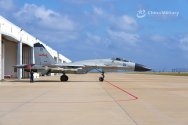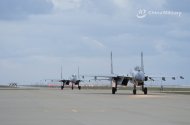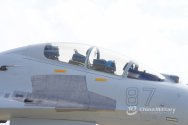You are using an out of date browser. It may not display this or other websites correctly.
You should upgrade or use an alternative browser.
You should upgrade or use an alternative browser.
China Flanker Thread II
- Thread starter sumdud
- Start date
- Status
- Not open for further replies.
If Russia secretly buys J16s and call them Su30XYZ, would anyone even notice?
HUD is different and quite noticeable.
Which airbase is this in STC?
It's quite interesting how the flanker platform has continued to transform in China. I really don't think things could've worked out this way with any other country.
If we look at when flankers were first being purchased by PLAAF, it was helped out by Russia's economic difficulty at the time. And because of Russia's economic difficulties, they were able to secure license production and transfer of technology. Unlike most countries out there, China had 2 competing institutes in Chengdu and Shenyang both building/designing their own aircraft. Since CAC got J-10 project, SAC was left free to carry out the task of building flankers. Without having 2 competing institutes, one project may have had to suffer if one was favored over the other. As we've seen with India and HAL, having both indigenous and license production projects in the same company is not optimal. Because of this healthy competition between SAC and CAC, SAC was pushed to quickly indigenize flankers locally as J-11B while they continued with J-11A production.
At the same time, China brought in over 100 Su-30MKK/2 despite the fact that all the Su-30s had very old avionics. In any other country, there would have been a lot of criticism for the MKK purchase, since PLAAF would soon induct aircraft that have better A2A combat and strike capabilities. In retrospect, the Su-30MKKs served 2 major purpose
1) deliver immediate capability with an offensive platform that could do ground strike and launch active guided medium range AAM. It allowed PLAAF pilots to starting training on these new capabilities and transition to an offensive air force a few years sooner. Might not sound like a lot, but PLAAF really values getting ability sooner and start training sooner.
2) serve as the basis for the J-16 project since China was quite involved in the development of Su-30MKK.
These are things that I didn't appreciate back 15 years ago, when I saw MKKs wasting away behind the new J-10/JH-7A combo sweeping through PLAAF/PLANAF. This definitely runs completely counter to the philosophy of Indians where they waited long time before the promised capabilities of MKIs become available. Even now, IAF is still waiting on Russians to deliver on what the super-MKI upgrade will look like. As we've seen over time, China's domestic industry has really fast tracked in the past 2 decades. Aside from WS-10 project, most domestic projects have finished on time. Relying on imports add to cost, uncertainty and makes maintenance more difficult. For example, China's J-10 production was affected by Russia's own procurement programs back in early to mid 2010s, since only so many AL-31s can be produced every year.
Which brings us to J-16. Most likely, they would've not been able to develop this without the MKKK experience. Without J-16, they would not have J-16D, which is a huge force multiplier. Without their experience with J-11B, it would've been much longer for SAC to develop J-15. Or China probably would've gone with a naval version of J-10, which would have shorter legs than naval flankers. As things stand, PLAN has 4th generation naval fighter jet with longer range and more payload than Rafale and F-18E/F. One could argue that J-15, even with AESA radar in the future, would be at a disadvantage in air combat. However, it would do really well serving as a multi-role missile truck and EW aircraft while complementing J-35s in the future carrier air wing.
I don't know if PLA saw these things ahead of time, but it has worked out pretty well for them.
If we look at when flankers were first being purchased by PLAAF, it was helped out by Russia's economic difficulty at the time. And because of Russia's economic difficulties, they were able to secure license production and transfer of technology. Unlike most countries out there, China had 2 competing institutes in Chengdu and Shenyang both building/designing their own aircraft. Since CAC got J-10 project, SAC was left free to carry out the task of building flankers. Without having 2 competing institutes, one project may have had to suffer if one was favored over the other. As we've seen with India and HAL, having both indigenous and license production projects in the same company is not optimal. Because of this healthy competition between SAC and CAC, SAC was pushed to quickly indigenize flankers locally as J-11B while they continued with J-11A production.
At the same time, China brought in over 100 Su-30MKK/2 despite the fact that all the Su-30s had very old avionics. In any other country, there would have been a lot of criticism for the MKK purchase, since PLAAF would soon induct aircraft that have better A2A combat and strike capabilities. In retrospect, the Su-30MKKs served 2 major purpose
1) deliver immediate capability with an offensive platform that could do ground strike and launch active guided medium range AAM. It allowed PLAAF pilots to starting training on these new capabilities and transition to an offensive air force a few years sooner. Might not sound like a lot, but PLAAF really values getting ability sooner and start training sooner.
2) serve as the basis for the J-16 project since China was quite involved in the development of Su-30MKK.
These are things that I didn't appreciate back 15 years ago, when I saw MKKs wasting away behind the new J-10/JH-7A combo sweeping through PLAAF/PLANAF. This definitely runs completely counter to the philosophy of Indians where they waited long time before the promised capabilities of MKIs become available. Even now, IAF is still waiting on Russians to deliver on what the super-MKI upgrade will look like. As we've seen over time, China's domestic industry has really fast tracked in the past 2 decades. Aside from WS-10 project, most domestic projects have finished on time. Relying on imports add to cost, uncertainty and makes maintenance more difficult. For example, China's J-10 production was affected by Russia's own procurement programs back in early to mid 2010s, since only so many AL-31s can be produced every year.
Which brings us to J-16. Most likely, they would've not been able to develop this without the MKKK experience. Without J-16, they would not have J-16D, which is a huge force multiplier. Without their experience with J-11B, it would've been much longer for SAC to develop J-15. Or China probably would've gone with a naval version of J-10, which would have shorter legs than naval flankers. As things stand, PLAN has 4th generation naval fighter jet with longer range and more payload than Rafale and F-18E/F. One could argue that J-15, even with AESA radar in the future, would be at a disadvantage in air combat. However, it would do really well serving as a multi-role missile truck and EW aircraft while complementing J-35s in the future carrier air wing.
I don't know if PLA saw these things ahead of time, but it has worked out pretty well for them.
Screen captures of J-16.





Looks like KD-88 and YJ-91 respectively.
I don't know if PLA saw these things ahead of time, but it has worked out pretty well for them.
And with SAC and CAC, they had a very deliberate policy of ensuring there are 2 companies competing with each other in the fighter space. This has been the case for decades.
We can also see they are very big on experimenting and prototyping to see what works and what doesn't, and in comparing against the Russian aircraft they buy directly.
So it leaves their options open depending on what they want to achieve in the future.
Looks like KD-88 and YJ-91 respectively.
Exactly ... but I cannot read the serial numbers! Concerning that they are using high- and low-vis markings mean it is a unit which gained them early.
That's not exactly what I am referring to. Obviously, having 2 competing companies allow them to progress faster in both j10 and flankers. That was something they had for a long time.And with SAC and CAC, they had a very deliberate policy of ensuring there are 2 companies competing with each other in the fighter space. This has been the case for decades.
We can also see they are very big on experimenting and prototyping to see what works and what doesn't, and in comparing against the Russian aircraft they buy directly.
So it leaves their options open depending on what they want to achieve in the future.
What I see differently is how they approached the induction of flankers vs how other countries did, namely India. Everything they did was something that you'd only expect to see in China. When they chose to license manufacture, they did not look to license manufacture the most advanced variant available. The technology on Su-30MKI is clearly more advanced. However, they needed the capability sooner. They wanted to get access to flanker assembly sooner, so that they can raise the level of SAC sooner and indigenize sooner. They had confidence that they'd be able to fully indigenize a modern 4th generation aircraft. Similarly, they didn't get license production of AL-31, but they set up the largest MRO plant for it outside of Russia. It was capable of pretty much everything other than producing new AL-31.
When they were procuring MKK, they knew it didn't have advanced electronics or sophisticated missiles. However, they were confident that better domestic options were coming along, so they ordered it for immediate capabilities anyhow. I'm sure back in their mind, MKK was picked due to their desire for a more capable flanker platform better suited for long range and multi-role missions. That seems to have been the objective based on people involved in the project. They didn't think they could make platform improvements as well as Sukhoi, so they went for the best platform available at the earliest point. With all that experience on it, they were able to develop J-16 based on all the experiences they've. Now, they have the most capable flanker aircraft in service anywhere. J-16 will also have application long after J-20 joins service in large numbers. If they had waited for the best Russian electronics before purchasing MKK, they would have never got the chance to develop J-16.
- Status
- Not open for further replies.



